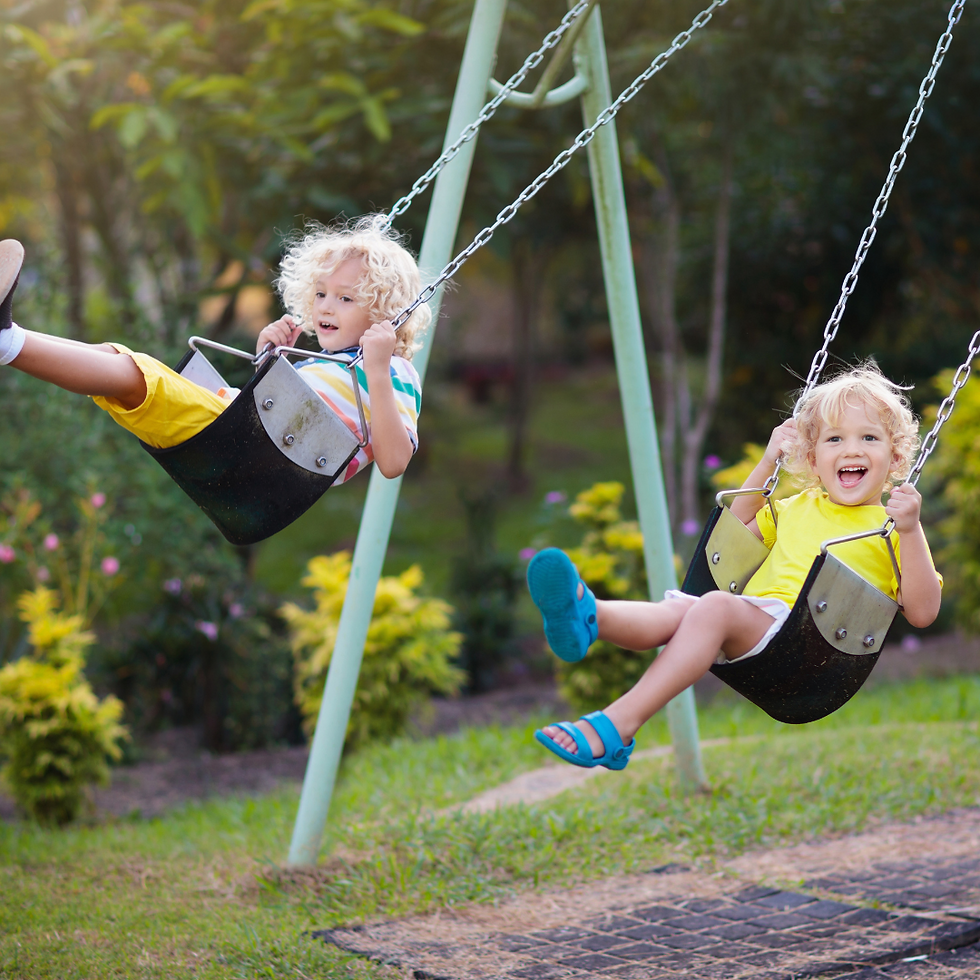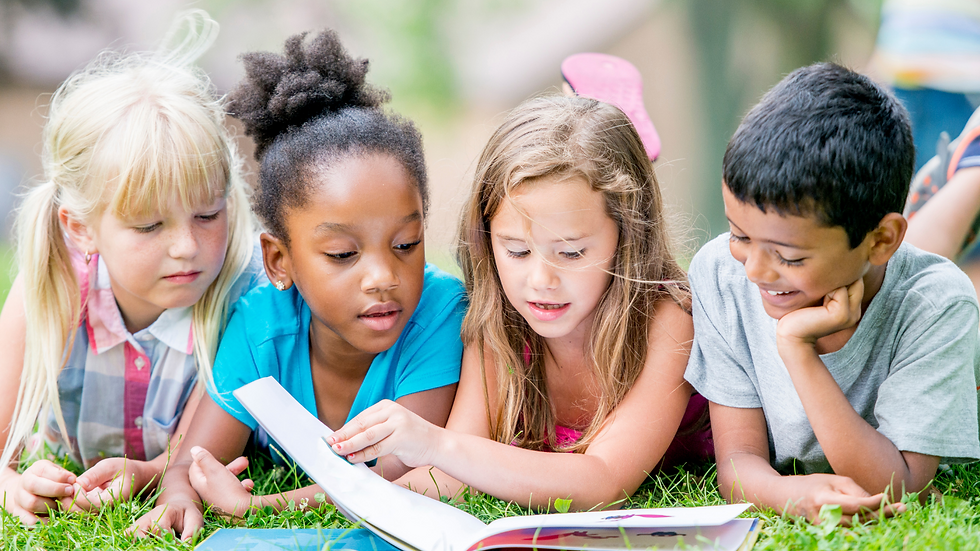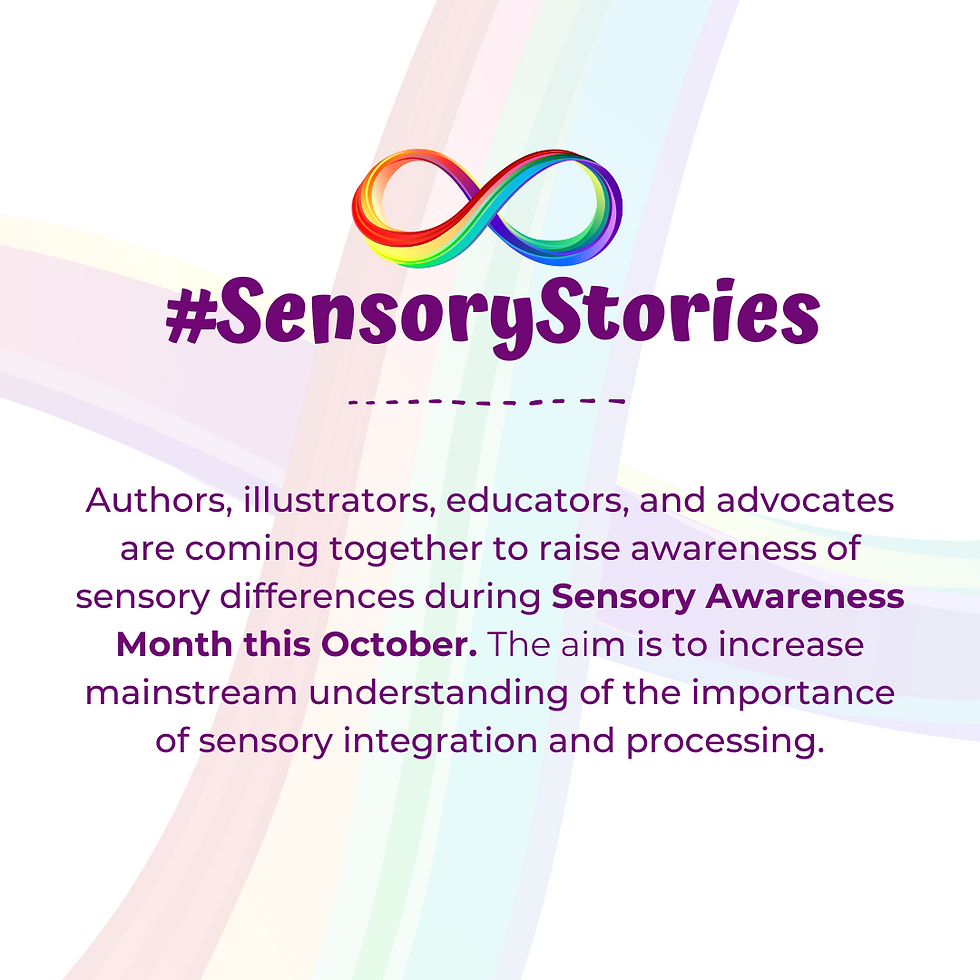#SensoryStories: 30+ Kids Books About Sensory Differences
- Wiggles, Stomps and Squeezes

- Aug 30
- 15 min read

We all know the 5 senses: touch, sight, hearing, smell, and taste.
Did you know there are 3 more?
These three lesser-known senses affect us every day! They are: Vestibular, Proprioception, and Interoception.

What does this mean for you?
1 in 6 children struggles daily with sensory processing challenges.* You probably know one or two. Maybe it is even you!

Sensory processing refers to the mechanisms of how we feel. It is how we use what we sense to make sense of the world around us, and it underpins every aspect of human functioning. Everyone processes sensation. The sensory messages we receive from our bodies and the world around us are responded to in every single thing we do in life. (*Stats from STAR Institute)
This can sometimes look like behavioral challenges, when in fact it is related to how we are processing the world around us. Every person is affected by their brain’s ability to properly process information from all of these senses to make sense of their world. Sometimes it is easy for us to self-regulate, and sometimes we can struggle. Learning to identify the areas and sensory inputs that we need support with as individuals helps us find ways to regulate our bodies and emotions.
Whoa, how do you explain that to a kid?
“We all feel sensory input differently — but it's hard to imagine what it’s like living in the body of people with experiences different than our own. Some people love riding on roller coasters and others get physically ill from them. Some people love spicy food and others prefer things blander. Some people enjoy a nice back scratch and others are tickled by the same kind of touch. In all of these examples, there’s no “right” or “wrong” side, just differences in the way each person processes the sensory input which leads to different preferences.” Caitlyn Berry, OTR/L Occupational Therapist, Pediatric Therapy
"When a child's brain processes certain sounds, smells, or physical sensations differently, they're often met with reprimand, as if it’s a behavioral choice on the child's part. Sensory differences are often misunderstood and frequently ignored. Representative books not only normalize different experiences, they also grow the garden of understanding, so children can process the world they live in the way they need to,” says Merriam Saunders, LMFT psychotherapist and author of My Whirling Twirling Motor, My Wandering Dreaming Mind, and Trouble with a Tiny T.

“Kids books that explore sensory differences are a great way for kids to find the language they need to express how they're feeling better and understand themselves more easily," adds Rebecca Burgess, autistic illustrator of Wiggles, Stomps and Squeezes Calm My Jitters Down. "I wish as a kid I'd had access to books like these, I think I could've communicated better to adults around me what I was feeling and what I needed to be less stressed! These books also help other people understand these experiences better too. Everyone experiences the world differently, and the more we can understand this the more compassion we can extend to each other.”
“Not only are there minimal resources in general, but there are also minimal resources that are specifically written for children. Without children's books and other kid-friendly content, how can our children learn about sensory processing and understand it?” says Nicole Filippone, autistic author of two sensory stories, Rosalee the Seeker and Alexander the Avoider. “Books like ours help children understand that their needs are valid and nothing to feel badly about. They help other children better understand the needs of their peers/siblings (even parents) who have SPD, enabling them to be empathetic and also to actually offer help if they can give it. In short, these books have the ability to transform the way families and classrooms operate with regard to sensory children.”

“Picture books are such a powerful tool! They allow readers to learn about things that are intangible or inaccessible in a way that feels approachable, predictable, and even fun! As a speech-language pathologist, I’m always looking for books that allow my students to see themselves and their classmates represented on the page, experience new things about the world around them, and make connections” says Kelsey Brown, SLP and author of Come On, Calm.

What is the #SensoryStories Campaign?
Authors, illustrators, educators, and advocates are coming together to raise awareness of sensory differences during Sensory Awareness Month this October. The aim is to increase mainstream understanding of the importance of sensory integration and processing.

"Each of us participating in this #SensoryStories campaign all have a similar goal — to help children and their families understand themselves better and get support for their sensory needs! Looking across the kid lit industry currently and seeing some wonderful new and recent titles not only addressing these differences, but coming from a place of understanding and compassion, I thought this was a great opportunity to come together to amplify these stories,” says Lindsey Rowe Parker, neurodivergent author of Wiggles Stomps and Squeezes Calm My Jitters Down.
“It's important to have books that empower kids with sensory differences to help them feel seen, known, and loved. We want to empower our kids to be their own best advocate." - Christia DeShields, Author of Sensory Seeking Sebastian

"I have spent my entire life experiencing the world in my own way. Much of that time, those close to me also needed help navigating and understanding how their minds work. Through these personal experiences, I saw a need for these books. Books that on the surface are simple, lighthearted, and sweet. Dig deeper, and they have nuanced stories to tell. Stories that illuminate and highlight sensitive feelings and experiences that many children have, not just those that are on the spectrum." Samantha Cotterill, Author and illustrator of This Beach Is Loud!, part of the Little Senses series
“I think sensory stories are so important because up until far too recently most people have had no understanding or awareness whatsoever about what sensory processing is and how drastically it can affect our lives - children and adults alike. I've seen nothing but positive changes in my children and my own life ever since we've begun the journey of trying to understand sensory processing.” Jacinta Read, illustrator of STAR Institute’s Sensory Stories.
"Our senses help us enjoy life, but when they are confused or overwhelmed, they get extra protective," says Jessica Sinarski LPCMH, author of the Riley The Brave Sensational Senses. "Sometimes that leads to behavior in kids that adults find frustrating and tough to make sense of—no pun intended. Picture books featuring sensory differences in a strengths-based way help to normalize and empower readers. When children are able to see their experience represented in story form, it peels away some of the shame and blame. With a more clear and affirming picture of what is really going on inside, kids gain the know-how to embrace who they are and live their sensational lives with confidence."
“I write so that neurodivergent kids with sensory differences like my own can see themselves in books. I write the books I didn’t know I needed, but I wish I had, growing up as an undiagnosed autistic girl with sensory differences.” Jen Malia, Author of TOO STICKY!
"I'm a person with Sensory Processing Disorder and a parent to kids with Sensory Processing Disorder. Everyone has different sensory preferences, so learning what overwhelms you and what helps calm you is important," says Jolene Gutiérrez, author of Too Much! An Overwhelming Day. "My hope is that by sharing this story told through a first-person point of view, even kids who have never experienced sensory overload will be able to put themselves in our main character's shoes and learn compassion through her journey. And kids with sensory sensitivities get to see someone like them in a book--what's better than seeing your own experience mirrored in a text?
Why create a more inclusive library, school, or bookshelf at home?
"It’s important to show children that some people experience the world differently. To teach openness and acceptance. I hope some children recognize themselves on the page and understand it’s ok to be a little different from others, and for parents and caregivers to realize there is nothing wrong with their child but that there is beauty in neurodiversity. They deserve to be understood and celebrated." Anne Alcott, author and illustrator of When Things Get Too Loud.
"Storytime should be inclusive of all students. This means picking books with main characters from different cultures and family structures, those with differing abilities, and those who use accessibility tools such as wheelchairs, hearing aids, and feeding tubes. This also includes sensory stories. This is a great place to start for educators and administrators wanting to better understand and support neurodivergent students, and those with sensory needs." Meghan Ashburn, education consultant, author and host of That Au-Some Book Club.
"Sensory stories are a great step toward flipping the script from a deficit lens to a sensory health lens," says Virginia Spielmann, PhD, Executive Director at the STAR Institute. "Being educated about the sensory dimension of our life helps us connected with our bodies. This helps us build self-esteem and self-awareness, and better relationships with others. It is great to see this work happening."
"Picture books on neurodiversity are fast-growing," says Prasha Sooful, author of My Brain Is Magic. "I think it's important to highlight and celebrate the positive aspects of sensory processing differences, to contribute to the understanding of this area, and also provide representation for these kids and families.'
"As a special education teacher of preschool students who are diagnosed with Autism and Speech/Language Impairment, I write stories that highlight ways in which we can modify the environment and provide the right tools so that children can thrive in their own way." - Aneta Cruz, educator and author of Juan Has The Jitters.
“Inclusive children’s books are imperative for all children,” says Dana Young-Askew, author of Come Meet Drayden. “Showing disabled and diverse characters ensures that kids feel seen. Kids want to see themselves as a part of the narrative. They want to know they belong. Representation builds confidence and affirms who you are. Representation matters.”
Here are 30+ books about sensory differences to add to your inclusive library or classroom!
Wiggles, Stomps, and Squeezes Calm my Jitters Down by neurodivergent author Lindsey Rowe Parker and autistic illustrator Rebecca Burgess. The vibration when she runs, the tap-tap-tap of her spoon on the table at mealtime, the trickle of cool water running over her hands—these are the things that calm her jitters down. The book is also available in Spanish, entitled Meneos, Pistones, Y Apretones Para Calmar Mi Cosquilleo.
Calming My Jitters At School - The highly anticipated second installment of the award-winning picture book series, Wiggles, Stomps, and Squeezes: Calming My Jitters at School. Written by Lindsey Rowe Parker, a neurodivergent mom, and beautifully illustrated by Rebecca Burgess, an autistic illustrator and advocate, this book offers a unique and profound understanding of sensory experiences that will resonate with parents, educators, and children alike.
My Brain is Magic by Prasha Sooful and Geeta Ladi. Whether your brain buzzes around the room like a bee or tells you to be loud and roar like a lion, celebrate the many things that it can be! This sensory-seeking celebration shines a light on neurodiversity and sensory processing in a fun and action-packed way for all children to enjoy.

Too Much!: An Overwhelming Day by Jolene Gutiérrez (Author), Angel Chang (Illustrator) Sometimes everything is too much! Too loud, too bright, and all too overwhelming. Writing from her own experience with sensory processing disorder, award-winning teacher-librarian Jolene Gutiérrez’s compassionate picture book explores the struggles of a sensorily sensitive child and how they settle themselves.
Riley the Brave's Sensational Senses by Jessica Sinarski and Zachary Kline. Riley the Brave is a little bear with big feelings. He really wants to have fun at the fair, but sometimes he struggles just to make it to school, especially on the STINKY, BUMPY, NOISY bus! Riley the Brave's Sensational Senses teaches children about their senses through a playful story with real-life strategies for emotion regulation.
#1 New York Times bestseller A Day With No Words invites readers into the life of an autistic family who communicates just as the child does, without spoken language. Written by an autistic mother of two autistic sons and the creator behind the popular @Fidgets.and.Fries social media platform and illustrated by Kate Cosgrove, A Day With No Words successfully normalizes communication methods outside of verbal speech and provides representation of neurodiversity and autism in a way that affirms and celebrates.
Little Digger's Big Garden by Jill Woodward (Author), Sarah Nettuno (Illustrator). Little Digger loves his big garden, but when he’s faced with a new food, he finds himself worried about how it will taste. With support from his friends, Tractor and Fire Truck, Little Digger finds the confidence to take a bite. Will he like this new food? The answer may surprise you.
Sensory Seeking Sloth by Jennifer Jones is a solution-based book that helps children understand Sensory Processing Disorder (SPD) and presents a sensory diet that offers tools and resources a child can use.
My Brother Otto by Meg Raby is a child-friendly, endearing, and fun picture book for children about the love, acceptance, and understanding a sister, Piper, has for her little brother Otto, who is on the autism spectrum. The book provides explanations for Otto’s differences and quirkiness in an easy-to-understand language, and highlights Otto’s desires for adventure and love—just like his peers.
Spencer's Noisy Mixer by Paige Amanda. Spencer Kimbell's special interest is baking. For her birthday, her mothers surprise her with a brand-new stand mixer! After the mixer causes their sibling Sid to have a sensory meltdown, the Kimbells help accommodate Sid's sensory needs by getting them some ear defenders.
My Busy, Busy Brain by neurodivergent author Nicole Russell. My Busy, Busy Brain provides practical tools for children struggling with controlling their emotions, impulses, and concentration. Nicole's experience encourages kids to embrace their special brains and provides a simple guide to take charge of their experience in the classroom and beyond.
Too Sticky! Sensory Issues with Autism - Holly loves doing experiments and learning new things in science class! But when she finds out the next experiment is making slime, she’s worried. Slime is made with glue, and glue is sticky. Holly has sensory issues because of her autism and doesn’t like anything sticky! With help from family and her teacher, Holly receives the accommodations and encouragement she needs to give slime a try. By Jen Malia, Illustrated by Joanne Lew-Vriethoff. Check out Jen Malia's new series The Infinity Rainbow Club!
The Boy with Big, Big Feelings by Brittany Winn Lee is relatable for any child -- especially for a child experiencing anxiety, extreme emotions, a child identified as a Highly Sensitive Person, or a child on the autism spectrum. Beautifully illustrated and written in rhyming verse, children and adults explore the whole spectrum of feelings and readers navigate the emotional challenges they face throughout the day.
Benji, the Bad Day, and Me by Sally J. Pla - Nothing seems to be going right for Sammy today. He finds his autistic little brother Benji is having a bad day too. Benji has a special play-box where he goes to feel cozy and safe. Sammy's convinced no one cares how he feels or even notices him. But somebody is noticing and has an idea on how to help Sammy feel better.
When My Brain Is Messy - Join the lovable young dinosaur on a journey through sensory experiences, where they rely on their parents' help to navigate overwhelming moments and big emotions. It's a story filled with understanding, compassion, and finding inner calm through regulating activities. Written by an autistic author and mother, Tania Wieclaw "When My Brain Is Messy" is written in a friendly and rhyming style that kids adore!
Rosalee The Seeker - Rosalee is a LITTLE sensory seeker with a BIG spirit, a BIG imagination, and an even BIGGER heart… and this is her story. Written & illustrated by Nicole Filippone.
Alexander the Avoider - Written to explain SPD from a child's perspective... to validate and empower them... to give them words to explain their needs... and to help adults better understand and support the children in their lives who struggle because of their SPD. Written & illustrated by Nicole Filippone.
Paisley the Perfectionist is the third book in a series by neurodivergent writer and illustrator Nicole Flippone. Perfectionist Paisley is a little perfectionist with the kindest heart…and this is her story.
Sensory Ninja by Mary Nhin shares what it's like to have sensory processing disorder and learns about a sensory diet that helps to prevent and calm triggers. The children's book series, Ninja Life Hacks, was developed to help children learn valuable life skills. Fun, pint-size characters in comedic books easy enough for young readers, yet witty enough for adults.

The Big Aquarium Adventure by Nancy Roop -
Stephen, a fourth grader, visits The Big Aquarium to look at many wild sea animals. But someone asks Stephen to touch a sea animal, and his body feels so scared that his hands are shaking. What will Stephen do next? An early chapter book with 3000 words and amazing full-color art is in a new Developmental format created with struggling readers in mind-ESL learners, too.
This Book is Overwhelmed by Anne Alcott. Oh boy, it’s me—Book—and I’m feeling *way* too frazzled! My pages are a scribbled mess, my words are running in circles, and my head feels so full I can’t even think straight. Is it “Once upon a…banana?” No, that’s not right! I’m overwhelmed, and I need *your* help to settle down, focus, and get my pages back on track. A fun and interactive story designed to help children understand and ease sensory overwhelm, sensory overload, and those moments when busy minds just can’t concentrate.
Before the Brave Bite by Madeha Ayub (Author), Maira Qaisar (Illustrator) follows a young boy named Darwin who has sensory sensitivities regarding food. Despite having a short list of preferred food items, Darwin learns to explore new textures and flavors at his own pace. With small steps and lots of courage, he discovers that simple tricks before the brave bite can lead to unexpected favorites.
Lily and the Snow - by Sara Stone (Author), Andy Yura (Illustrator). With snow all around, can Lily find joy outdoors? Can she work with her Sensory Processing Disorder and find a comfortable way to play? Come along for a heartfelt story about overcoming obstacles while staying true to yourself.
Come Meet Drayden - Drayden's siblings will be sharing what a typical day with Drayden is like. Drayden has Autism and is completely awesome! A book celebrating diversity & inclusion. By Dana Young-Askew and illustrated by Cameron Wilson.
No Such Thing As Normal by Megan Dejarnett speaks to the curiosities and difficult questions that arise in a world full of diversity. Equipped with discussion questions, this story provides a creative ahonest and interactive way to instill dignity and respect for all people. This book is designed to teach inclusion, diversity, and acceptance.
Come On Calm - A whimsical children's book encouraging readers of all abilities to self-regulate through sensory and breathing tasks. From author Kelsey Brown and illustrator Joseph Wrightson.
The Sensory Zoo by W.C Doyle (Author), Stephen Young (Illustrator) - A zoo keeper takes a walk through her zoo and notices that many of her animals are struggling with what’s going on around them. It is up to the keeper to help the animals with their sensory needs so they can enjoy their time at the zoo.
Sensory Seeking Sebastian - Sensory Seeking Sebastian is a book that empowers sensory seekers with strategies that help with self-regulation. This book is perfect for families who want to equip their sensory seeker to navigate the challenges of ADHD, Autism, and SPD. By Christia DeShields and illustrated by Marissa Nelson.
When Things Get Too Loud -When Things Get Too Loud is a story about sensory overload, how it feels, what can trigger it, and what may help. The Feel-O-Meter provides the child and parents with a visual guide through emotions and the book comes with ideas to cope with overwhelming situations. Written by Anne Alcott.
Juan Has the Jitters - Juan claps his hands to get his Jitters out. They make his tummy swoosh and swirl. His Jitters happen when there are too many people, too much noise, or too many changes to his day. Juan doesn’t like surprises. By Aneta Cruz, illustrated by Miki Yamamoto.
My Whirling, Twirling Motor - Charlie feels like he has a whirling, twirling motor running inside him all the time, and sometimes he just can’t settle. When his mom wants to talk to him, he figures he’s in trouble…but she has a surprise for him instead! Includes a Note to Parents, Caregivers, and Teachers with more information on ADHD, behavior management, and helping children focus on the positives. By Merriam Sarcia Saunders, Illustrated by Tammie Lyon.
This Beach Is Loud! Going to the beach is exciting. But it can also be busy. And loud. Sand can feel hot or itchy or sticky…and it gets everywhere! In This Beach Is Loud!, a sensitive boy gets overwhelmed by all the sights, sounds, and sensations at the beach. Luckily, this kiddo’s dad has a trick up his sleeve to help his son face these unexpected obstacles. Written and Illustrated by Samantha Cotterill.
STAR Institute Sensory Stories *digital format - Five real-life stories from the STAR Institute highlighting the incredible importance of sensory integration and processing for health and well-being. By Virginia Spielmann, illustrated by Jacinta Read.
How can you participate in Sensory Awareness Month? Easy!
Add inclusive books like the ones on this list to your library, share with your school, or gift them to a local organization.
Share #sensorystories with your social media followers, or add your voice to the conversation of why sharing these stories is important. Share books that you love that we missed!
Follow neurodivergent, autistic, and other advocates that have the lived experience of sensory differences, and learn from them.
Learn how to provide accommodations and support for children and adults with sensory differences through organizations like the STAR Institute: Sensory Processing.
Hug an OT! Thank your educators, therapists, and advocates that are actively seeking to make spaces and experiences more friendly to those with sensory differences.
**30+ books just not enough for you?
P.S. before you go...
Share this list! Click the social icons below! You know someone who needs this, I pinky swear.







































link link link link link link link link link link link link link link link link link link link link link link link link link link link link link link link link link link link link link link link link link link link link link link link link link link link link link link link link link link link link link link link link link link link link link link link link link link link link link link link link link link link link link link link link link link link link link link link link link link link link link link link link link link link link link link link link link link link